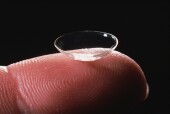
SUNDAY, May 31, 2015 (HealthDay News) — Changes in bacteria populations may be one reason why people who wear contact lenses are more prone to eye infections, a new study suggests.
“Our research clearly shows that putting a foreign object, such as a contact lens, on the eye is not a neutral act,” senior study investigator Maria Gloria Dominguez-Bello, a microbiologist at NYU Langone Medical Center, said in a Langone news release.
“What we hope our future experiments will show is whether these changes in the eye microbiome of lens wearers are due to fingers touching the eye, or from the lens’s direct pressure affecting and altering the immune system in the eye and what bacteria are suppressed or are allowed to thrive,” she added.
For the study, researchers took samples from nine daily contact lens wearers and 11 others who didn’t use contact lenses. They found that the types of bacteria in the eyes of the contact wearers more closely resembled those found on eyelid skin than in the eyes of those who don’t use contacts.
Specifically, the researchers found that the eye surface had a greater variety of bacteria than the skin directly beneath the eye. They also found that the eyes of contact lens users had three times the usual levels of certain bacteria than the eyes of those who didn’t use contact lenses.
The findings were to be presented Sunday at the annual meeting of the American Society for Microbiology, in New Orleans. Findings presented at meetings are typically considered preliminary until they’ve been published in a peer-reviewed journal.
“These findings should help scientists better understand the longstanding problem of why contact-lens wearers are more prone to eye infections than non-lens wearers,” Dominguez-Bello said.
That understanding could lead to better ways of preventing eye infections in contact lens wearers, the researchers said.
More information
The American Academy of Ophthalmology has more about contact lens-related eye infections.
Copyright © 2025 HealthDay. All rights reserved.

